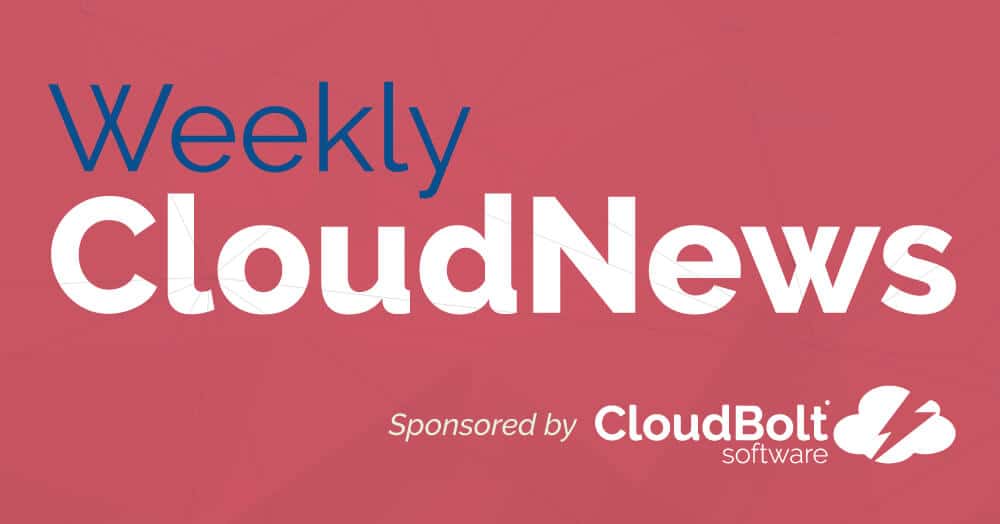Weekly CloudNews: Cloud Spending Back Up Again

Welcome to this week’s edition of CloudBolt’s Weekly CloudNews!
This week we added two new resources to our Resource Center, eBooks to help customers solve their vexing CI/CD challenges, and navigate the upcoming migration from VMware vRealize Automation 7 to 8 before end-of-support for vRA 7 later this year.
With that, onto this week’s news:
Cloud computing spend grows again after slight dip
Liam Tung, ZDNet, Jan. 18, 2022
“Global spending on cloud infrastructure returned to growth in Q3 2021 after the first quarterly decline since the pandemic triggered a massive increase in spending. According to researcher IDC, spending on cloud infrastructure across dedicated and shared environments increased 6.6% year on year to $18.6 billion in Q3 2021. The growth put spending back on track with the seven consecutive quarters of growth since Q3 2019, with the exception of the 1.9% decline in Q2 2021. The main boost in cloud spending happened in Q2 2020, which saw 38.4% year-on-year growth.
Cloud, whether dedicated or shared, is expected to continue to eat into traditional hardware spending in the future. The 2020 split on spending between ‘non-cloud & dedicated’, ‘cloud & shared’, and ‘cloud & dedicated’ infrastructure was 46.4%, 37.5%, and 16.2%. IDC expects this order to be reversed by 2025: by then it expects spending on compute and storage cloud infrastructure to reach $118.8 billion and account for 67% of all compute and storage spend. Of that amount spent on cloud, shared infrastructure will dominate cloud spending with a 70.9% of that investment. Cloud infrastructure spending in 2021 is likely to have grown 8.3% compared to 2020 to $71.8 billion, according to IDC projections. Meanwhile, spending on non-cloud IT infrastructure is expected to have grown just 1.9% in 2021 to $58.4 billion, which is actually a positive result after two years of decline.”
What to do in ’22: six cloud trends for the year ahead
Paul Delory, SiliconANGLE, Jan. 16, 2022
“Cloud services let smart business leaders respond quickly to opportunities — or threats. So don’t get in the way. You cannot let debates over technical minutiae derail the quick transition to cloud services — even if that means making uncomfortable compromises in initial implementation quality. However, you cannot abdicate your responsibility to keep business functions safe and highly available. Rather, you must implement flexible governance frameworks that can handle different risk profiles. Optimize cost and risk based on the business needs. You should:
- Build a cloud adoption framework: A good framework is reusable, so that you can onboard new services rapidly while implementing lessons learned and avoiding past mistakes.
- Mitigate risks created by suboptimal cloud adoption: Cloud incurs risks of supply, availability, confidentiality, compliance, concentration and overspending. You must build compensating controls for each.
- Develop a strategic cloud operating model: Formal governing bodies such as advisory councils, communities of practice and a cloud center of excellence will help.
Red Hat Integrates IT Automation for Hybrid Cloud With Microsoft Azure
Chris Ehlrich, Datamation, Jan. 18, 2021
“The open-source software maker Red Hat is integrating its IT automation software for Microsoft Azure. The Red Hat Ansible Automation Platform on Microsoft Azure builds on Red Hat’s standard for hybrid cloud automation and brings it more deeply into the application development lifecycle, according to Red Hat last month. The collaboration between Red Hat and Microsoft is intended to provide customers flexibility in how they adopt automation and scale in hybrid clouds and at the edge to “deliver any application anywhere,” without additional overhead or complexity.
Users can work on scenarios such as automated OS configuration, application provisioning, network automation, infrastructure-as-code (IaC), and cybersecurity orchestration.
The integration with Azure services, including Azure compute, network, and storage, can allow customers to scale their IT operations. Virtually all organizations (97%) see major barriers to their ability to effectively employ automation across their enterprise, according to IDC. Through 2023, many IT automation efforts will be delayed or fail outright due to under-investment in creating IT/Sec/DevOps teams with the right tools and skills. Red Hat Ansible Automation Platform on Azure is designed to remove the infrastructure maintenance and operational burden from IT teams, enabling them to focus on delivering automation strategies for a more efficient business.”
We’re here to help you anywhere on your hybrid and multi-cloud journey. Request a demo today.
Related Blogs

The Future of Cloud Cost Management and Optimization is Here with CloudBolt
It’s an exciting time to be in the Cloud Cost Management and Optimization space. The landscape is quickly changing as…

